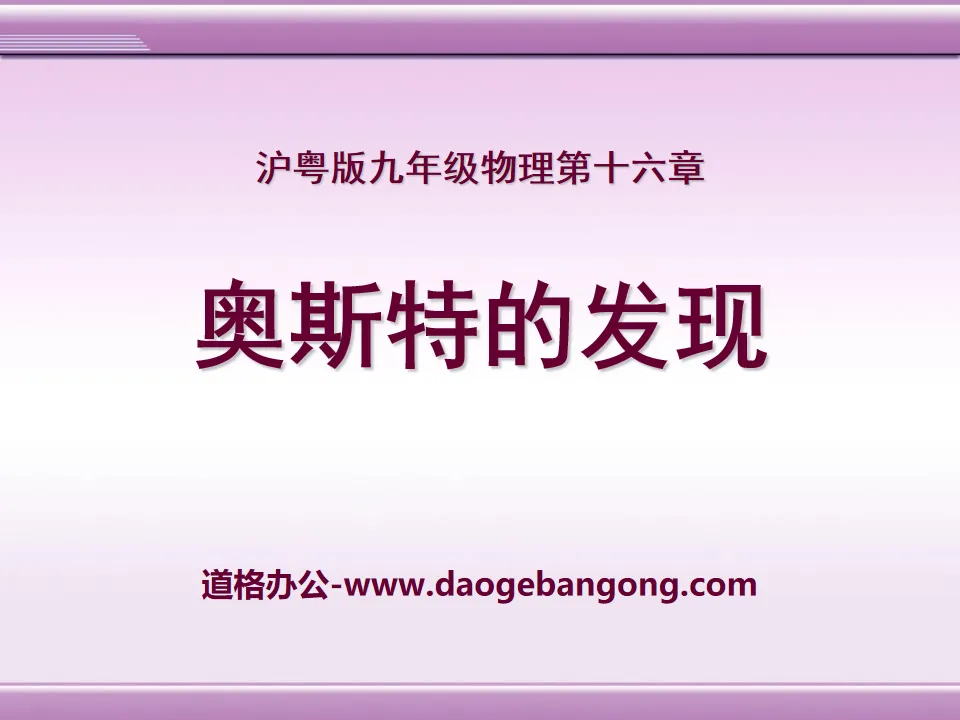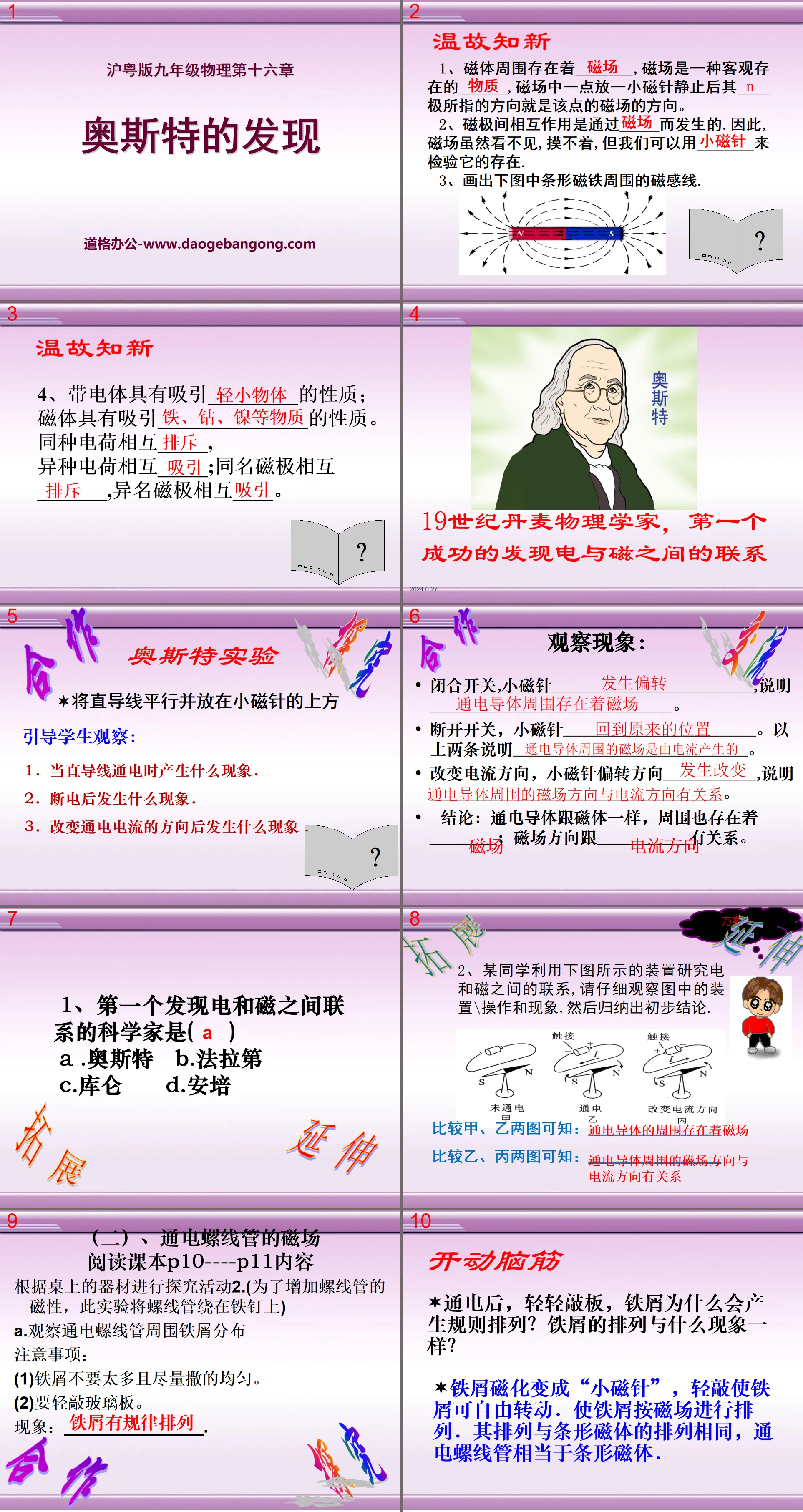People's Education Edition Physics for Grade 8, Volume 2
People's Education Edition Physics for Grade 8, Volume 1
People's Education Edition Ninth Grade Physics Complete Book
Shanghai Science Edition Ninth Grade Physics
Shanghai Science Edition 8th Grade Physics
Beijing Normal University eighth grade physics volume one
Lu Jiao Edition Ninth Grade Physics Volume 2
Beijing Normal University Ninth Grade Physics Volume 1
Lu Ke Edition High School Physics Compulsory Course One
Guangdong and Shanghai Edition Ninth Grade Physics Volume 1
Lu Jiao Edition Ninth Grade Physics Volume 1
People's Education Press High School Physics Compulsory Course II
Beijing Normal University Ninth Grade Physics Volume 2
Lu Jiao Edition Eighth Grade Physics Volume 2
Lu Jiao edition eighth grade physics volume 1
Guangdong and Shanghai Edition Ninth Grade Physics Volume 2

| Category | Format | Size |
|---|---|---|
| Guangdong and Shanghai Edition Ninth Grade Physics Volume 2 | pptx | 6 MB |
Description
"Oersted's Discovery" Electromagnet and Automatic Control PPT Courseware
Review the past and learn the new
1. There are _______ around the magnet. The magnetic field is an objectively existing ______. When a small magnetic needle is placed at a point in the magnetic field and comes to rest, the direction pointed by its ____ pole is the direction of the magnetic field at that point.
2. The interaction between magnetic poles occurs through _____. Therefore, although the magnetic field is invisible and intangible, we can use _______ to test its existence.
3. Draw the magnetic field lines around the bar magnet in the picture below.
4. Charged objects have the property of attracting ________; magnets have the property of attracting _______________. Like charges _____ each other, charges of different types _____ each other; magnetic poles with the same name _____ each other, and magnetic poles with different names ____ each other.
Oersted experiment
Place the straight wire parallel to the small magnetic needle
Guide students to observe:
1. What happens when a straight wire is energized?
2. What happens after a power outage?
3. What happens when the direction of the current is changed?
Observation phenomenon:
Close the switch, the small magnetic needle ____________________, instructions ____________________.
Turn off the switch, the small magnetic needle ____________________. The above two instructions ____________________.
Change the direction of the current, and the small magnetic needle deflects in the direction of___________, indicating_________________________.
Conclusion: Like a magnet, a current-carrying conductor also has _________ around it; the direction of the magnetic field is related to ___________.
Expand and extend
1. The first scientist to discover the connection between electricity and magnetism was ( )
A. Oersted B. Faraday
C. Coulomb D. Ampere
2. A student uses the device shown in the picture below to study the connection between electricity and magnetism. Please carefully observe the device\operation and phenomenon in the picture, and then draw a preliminary conclusion.
Comparing the two pictures A and B, we can see that there is a magnetic field around the current-carrying conductor.
Comparing Figures B and C, we can see that the direction of the magnetic field around a current-carrying conductor is related to the direction of the current.
Conduct exploration activity 2 based on the equipment on the table. (In order to increase the magnetism of the solenoid, this experiment will wrap the solenoid around an iron nail)
A. Observe the distribution of iron filings around the energized solenoid
Precautions:
(1) Don’t have too many iron filings and spread them as evenly as possible.
(2) Tap the glass plate lightly.
Phenomenon:_______________.
B. Use the equipment on the table to explore the polarity of the energized solenoid
Place the small magnetic needles at both ends of the energized solenoid and observe the direction of the N pole when the small magnetic needles are at rest.
Change the direction of the current. When the small magnetic needle is stationary, the N pole points to _____ (fill in "change" or "no change").
Explanation: The direction of the magnetic field of the energized solenoid is related to _______.
Right-hand spiral rule (Ampere's rule)
Hold the solenoid with your right hand and bend your four fingers in the same direction as the current in the solenoid. The end pointed by your thumb is the N pole of the solenoid.
Keywords: Electromagnets and automatic control teaching courseware, Oster's discovery teaching courseware, Guangdong and Shanghai version ninth grade physics PPT courseware download, ninth grade physics slide courseware download, electromagnets and automatic control PPT courseware download, Oster Download the special discovery PPT courseware in .PPT format;
For more information about the PPT courseware "Electromagnets and Automatic Control Oersted's Discovery", please click the Electromagnets and Automatic Control ppt Oersted's Discovery ppt tag.
"Oersted's Discovery" Electromagnets and Automatic Control PPT Courseware 3:
"Oersted's Discovery" Electromagnets and Automatic Control PPT Courseware 3 Oersted Experiment Conclusion: 1. There is a magnetic field around the energized wire; 2. The direction of the magnetic field of the current is related to the direction of the current. This phenomenon is called the magnetic effect of electric current. Oersted's experiment shows that: 1. Electric conduction...
"Oersted's Discovery" Electromagnet and Automatic Control PPT Courseware 2:
"Oersted's Discovery" Electromagnets and Automatic Control PPT Courseware 2 Similarities between Electric Phenomenon and Magnetism Phenomenon Electric Phenomenon Charged bodies can attract ________. There are ___ charges and ____ charges in nature. Like charges ____ each other, and dissimilar charges ____ each other. Magnetic phenomena ..
File Info
Update Time: 2024-11-23
This template belongs to Physics courseware Guangdong and Shanghai Edition Ninth Grade Physics Volume 2 industry PPT template
"Oersted's Discovery" Electromagnet and Automatic Control PPT Courseware Simple campus recruitment activity planning plan summary enterprise and institution recruitment publicity lecture PPT template is a general PPT template for business post competition provided by the manuscript PPT, simple campus recruitment activity planning plan summary enterprise and institution recruitment promotion Lecture PPT template, you can edit and modify the text and pictures in the source file by downloading the source file. If you want more exquisite business PPT templates, you can come to grid resource. Doug resource PPT, massive PPT template slide material download, we only make high-quality PPT templates!
Tips: If you open the template and feel that it is not suitable for all your needs, you can search for related content "Oersted's Discovery" Electromagnet and Automatic Control PPT Courseware is enough.
How to use the Windows system template
Directly decompress the file and use it with office or wps
How to use the Mac system template
Directly decompress the file and use it Office or wps can be used
Related reading
For more detailed PPT-related tutorials and font tutorials, you can view: Click to see
How to create a high-quality technological sense PPT? 4 ways to share the bottom of the box
Notice
Do not download in WeChat, Zhihu, QQ, built-in browsers, please use mobile browsers to download! If you are a mobile phone user, please download it on your computer!
1. The manuscript PPT is only for study and reference, please delete it 24 hours after downloading.
2. If the resource involves your legitimate rights and interests, delete it immediately.
3. Contact information: service@daogebangong.com
"Oersted's Discovery" Electromagnet and Automatic Control PPT Courseware, due to usage restrictions, it is only for personal study and reference use. For commercial use, please go to the relevant official website for authorization.
(Personal non-commercial use refers to the use of this font to complete the display of personal works, including but not limited to the design of personal papers, resumes, etc.)
Preview










